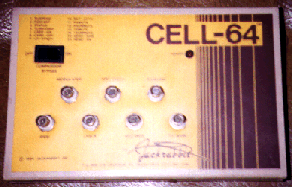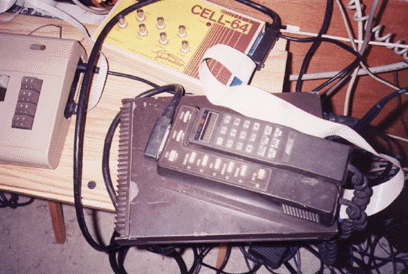
I picked up this odd-looking device at a flea market two summers ago.
I attempted to reverse engineer it, and have been searching for software
and information for quite a while. I ended up finding a complete Cell-64
set-up at a flea market, complete with all cables, software, and
manuals.
I set up my Commodore 64 station and hooked up the Cell-64. The system was
very easy to set up and I had it working within 15 minutes. The
unit plugs into the C-64 expansion port and one of the joystick
ports (for power):

Upon start-up of the program, you are greeted with the following splash
screen:

This is the main menu (status screen):

Hitting "G" from the main menu will present you with a list of commands.
These commands are then sent to the cellular phone (which is placed into a
suspended "debug" mode). By selecting command #12 (RXUNMUTE), one can
un-mute the receiving audio and, by changing channels, listen to cellular
phone calls. With newer cell phones, these debug features are integrated
into the phone and you don't need a third-party program like
Cell-64:


The "Cell-64" is some kind of "breakout box" for cellular phone
testing and repair. It
was made by a company called "Jackrabbit" and copywritten 1984. The box has 7
BNC connectors on it, 2 Centronics connectors (for the cell phone connection)
and an edge-card connector that goes to either the C-64 expansion port or
serial port. The Centronics connectors match with those used in some of the
first cellular/mobile phones, back in 1983-1984. On those phones, they were
used to connect the control head (handset) to the rest of the unit. It looks
like this device is connected in series between the control head and the rest
of the phone, "breaking out" certain signals to the BNC connectors.
The BNC connectors are labeled:
- MODULATOR
- NRZ CLOCK
- RX AUDIO
- RSSI
- DISCR
- NRZ DATA
- TX AUDIO
There is also a switch (upper left) with a label "COMPANDOR BYPASS". Inside
the unit are some diodes and other interfacing circuitry. Near the switch, the
following is printed:
1. SUSPEND 10. SET-ATTN
2. RESTART 11. RXMUTE
3. STATUS 12. RXUNMUTE
5. TURNARND 13. TXMUTE
7. CARR-ON 14. TXUNMUTE
8. CARR-OFF 22. SEND-NAM
9. LD-SYNTH 24. SEND-SN
8/12/97 UPDATE!
I have started trying to reverse engineer this thing, and so far it has
been a pain in the ass. There are two ICs, but the markings are scratched
off the tops, probably to prevent reverse engineering (thanks a lot!). The
connector is a 26-pin male which connects to the 24-pin User Port of the
C-64. The pinouts of the two are completely different.
So far, I have found +5V, GND, and the 8 pins which go to PB0-PB7 of the
User Port. There are still 5 pins left which go to the unmarked ICs, and
one pin which comes from the Collector of a 2N3906 transistor. I assume
these connections are for RESET or SER. ATN IN on the User Port, but there
is no way to tell.
Thanks to Frank who mailed me the supposed Cell-64 software, I could try
and run the software to see what would happen. Most of the files are
hidden, and unfortunately, the program only prints "Loading...", then
returns to the BASIC prompt. I assume it does a type of "dongle" check to
see if the Cell-64 unit is attached to the User Port, and if not, stops
loading.
There is not much more I can do at this point without some kind of cable
pin-outs between the Cell-64 and C-64 User Port.
I know this hardware interfaces with the Commodore 64, possibly to display
phone signals on the screen. A recent post on Usenet came up with nothing,
except for a few people telling me this "must be some kind of printer". Duh.
I don't think so.
LINKS
 Commodore 8-bit WWW server
Commodore 8-bit WWW server
comp.sys.cbm
alt.binaries.cbm

Last update occurred on 4/9/98 at 5:50pm
kingpin@l0pht.com







 Commodore 8-bit WWW server
Commodore 8-bit WWW server